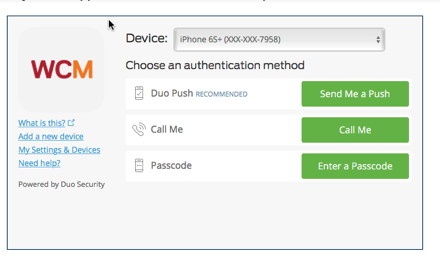Do I need to re-register my email account when I install Duo?
No.
If I travel abroad and buy a local phone/SIM card while I’m there, can I still use Duo to access the network?
Yes. To do this, you can borrow a FOB Key (a small authentication device) from ITS. Please stop by the SMARTDesk at 1300 York in the Library a few days prior to your departure to borrow a Duo FOB. If you travel frequently you may want to purchase your own key ($18 to $50). We suggest either the FIDO U2F Security Key, YubiKey 4 or YubiKey 4 Nano. http://www.amazon.com/s/field-keywords=yubikey .
If you travel abroad and use your own phone, use the “Enter a Passcode” authentication method to access Duo enabled sites.
Do I need to be connected to the Internet to use the Duo app?
No. After you register with Duo, using the app does not require Internet connectivity. If your phone is not connected to the internet and you need to use the Duo app, choose the “Enter a passcode” option as an authentication method as shown on the screen below. This screen should appear when you try to login to a site that requires two-factor authentication.

Then, get your passcode by tapping the key button on your Duo app screen. This works anywhere, even in places where you don’t have an internet connection or can’t get cell service.

Does the phone on which I’d like to install Duo need to be tagged by ITS?
No, you can install Duo on any device whether it is tagged by ITS or not.
Why is ITS requiring two-factor authentication?
Phishing is a leading method used by hackers to gain access to your password, data, and compromise your accounts. A second layer of security helps significantly to mitigate this risk. In fact, two-factor authentication is one of the best ways to protect against remote attacks on WCM accounts such as phishing, credential exploitation and other attempts to takeover your accounts. When two-factor authentication is enabled with web-based applications, such as myApps, remote attackers are unable to access your accounts without possessing your physical device needed to complete the second factor.